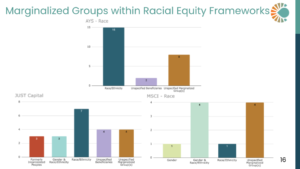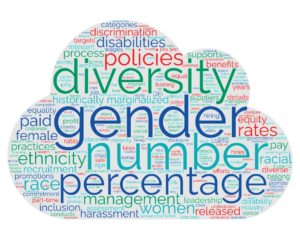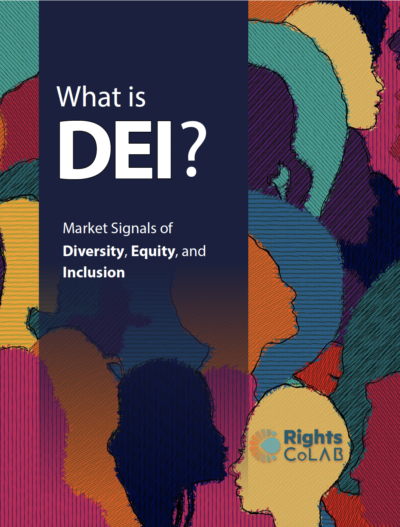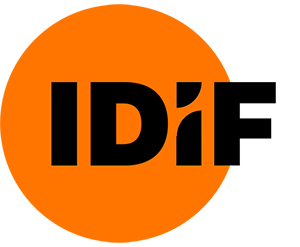Joanne Bauer, Sharlene Brown, and Rashika Choudhary on how race shows up in the mapped metrics
Discussion moderated by Samantha Katz, IDiF Board Member and Co-Founder
On October 12, 2022, IDIF hosted an online Fireside Chat for its community leaders featuring the DEI Mapping Report. The event shone a spotlight on one specific theme of the report: how race is showing up in the metrics. During the session, we encouraged participants to share views on whether the metrics accurately reflect what we want to see for race and ethnicity DEI goals. To home in on this issue, we created new visualizations, which do not appear in the report, of the mapping findings on race/ethnicity metrics.

The presence of metrics that reference marginalized groups other than race in racial equity frameworks points to a means of capturing intersectionality in workforce data.

The prevalence of race/ethnicity metrics in U.S. frameworks as compared to global frameworks. Commentators suggest that there is less of a focus on race outside of the United States, an assertion that is borne out in the metrics.

The distribution of race/ethnicity metrics across 12 topics and subtopics: all frameworks.
Following a presentation of the report, author Joanne Bauer engaged Sharlene Brown, Croatan Institute Senior Fellow, Director of the Institute’s initiative on Racial Equity, Economics, Finance, and Sustainability (REEFS), and co-author of Capital at a Crossroads, in an exchange about the emergence of racial equity lens in investing and the place of race in DEI performance assessments.
Sharlene began by noting that historically there’s always been an effort to try to focus on DEI and that the practitioner community is now actively questioning whether it has been prioritized. The Rights CoLab report corroborates what Sharlene and her colleagues have been seeing: that from 2020 onwards, there was a marked shift in attention to race. What we are seeing now is “early stage work,” but the private secctor focus on race feels significantly stronger, according to Brown.
When asked where in her view the report reveals gaps in DEI priorities, Sharlene responded that “the accountability piece is crucial.” The fact that we are not seeing more accountability metrics at the management and board level is problematic, and “tied to the way we do business in the world.” For the past two decades the U.S. has become a majority-minority country, and this means “we need to think very differently about how we invest in people.” If companies do not recognize this, they risk losing out in global competiting. According to Sharlene, “We need to see this as a moment to invest in communities that we have historically ignored. In the U.S. we have a huge opportunity ahead of us to lean into the changes that are coming and to make sure the investments are made so that companies can compete in a global landscape. Not doing so is reckless.”
Joanne then asked Sharlene about a finding of the research whereby class and social mobility rarely appear in the metrics. Sharlene agreed that this is signficiant. She applauded the growing focus within the DEI community on diversity of asset managers, but cautioned that this conversation sometimes leaves out a critical issue: the wealth and income gap. According to Sharlene , we need to ask “How do we lift the broader masses and bring greater equity for communities?” We are just at the starting point in reflecting the answer to this question in the metrics. Joanne remarked that for the private sector, the answer may lie in a new commitment to recruitment practices that move away from targeting mainly graduates of the elite univiersities and towards attracting a new pool of talent through loan repayment programs and on-the-job training.
Joanne turned to Rashika Choudhary, a project researcher and the creator of the visualizations that appear in the report, for her reflections on the mapping, particularly as a younger person facing the job market. Choudhary remarked that she recognized a clear emphasis on diversity metrics, and that DEI goals need to capture the cultural changes that are underpinned and result from inclusion and equity. These DEI measures are weakly represented across the frameworks and need greater attention.

Word cloud of the 429 metrics mapped
Q&A Moderated by Samantha Katz, CoFounder IDIF:
Why did you choose “Race/Ethnicity” as a category for the Mapping Report?
We created categories that mirror the language present in the metrics themselves. Therefore, where the metrics refer to “race,” “ethicity,” or “race/ethnicity” we do, too. The purpose of the report is to reflect the state of the DEI field today, so we did our best to record as accurately as possible how DEI is defined by the metrics.
How would you like to see DEI goals evolve?
The present focus on quantitative diversity metrics does a poor job of capturing the cultural issues in a workplace that lead to discrimination. According to Rashika Choudhary, “Everyone should benefit from DEI, or else it goes against the nature of ‘inclusivity.’” Other gaps, as noted in the key findings section of the report, is that the metrics don’t do a very good job of capturing intersectionality. And as noted above, we need to consider how to bring a focus on class and social inclusion into our DEI goals.
Why do you believe there are no metrics on migrants or immigrants, especially considering the intersection of internal DEI progress and supply chain issues? Do you foresee any progress in this area specifically?
By identifying this gap, we hope this report will shine a light on this overlooked aspect of DEI. The oversight may stem from the fact that DEI tends to be seen as relating only to a company’s direct workforce, whereas labor issues in the supply chain are considered human rights matters. This is a false dichotomy. Discrimination sits at the core of abuses within the supply chain, and migrants are among the most vulnerable in any given society. A DEI lens on supply chain issues can shed light on those most at risk and is important to identifying, preventing, and addressing harms to the people who toil deep in a company’s supply chain and for the company iteself. Similarly, discriminatory treatment within the direct workforce is fundamentally a human rights issues, and should be understood as such.
We noticed a DEI framework that is not in the mapping. Will Rights CoLab be releasing an update?
This is an evolving topic and the Rights CoLab mapping represents the state of play at a point in time. Although we do not currently have plans to update the mapping, we welcome any tips on what is missing so that we can assess whether the new information changes our findings. To facilitate this, we have prepared a form which can be accessed here. Any change in our findings will be noted on this page.
The report lays out our selection criteria, one of which is that it be a framework with publicly available metrics that we can include in our open spreadsheet. Further details on the criteria are provided in Appendix 3, “What is Missing from the Mapping.”
Photo by Mike Erskine on Unsplash


